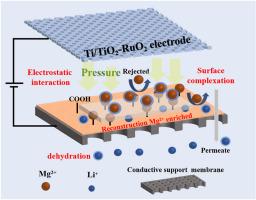在电场下通过带有导电基底的纳滤膜高效分离 Li+/Mg2+
IF 8.4
1区 工程技术
Q1 ENGINEERING, CHEMICAL
引用次数: 0
摘要
电纳滤(ENF)实现了锂⁺/Mg2⁺的高效分离。纳滤膜的导电性对 ENF 过程有显著影响。本研究通过界面聚合法制备了导电聚醚砜(PES)/MXene@CNT膜,并将其用于ENF工艺中,实现了锂⁺/Mg2⁺的高效、精确分离。研究发现,在 PES 膜中添加 MXene 和 CNT 后,PES/MXene@CNT 膜具有相当好的导电性(>0.5 S/m)和亲水性。即使在低电压下,带有导电基底的 ENF 膜也能表现出极其出色的 Li⁺/Mg2⁺ 分离性能。这是因为在ENF过程中,NF膜的导电基底可直接被视为阴极,从而增强电场强度和电流密度,更适合表面电荷重构和Li+传输。当电压为 2.5 V 时,Mg2+ 几乎被完全排斥;而 Li+ 的排斥率高达 -100.6%。在 2.5 V 电压下,Li⁺/Mg2⁺ 分离因子(SLi,Mg)高达 1164.6,远高于采用非导电支撑膜的普通 NF 膜(SLi,Mg = 25.7)。ENF 在 2.5 V 下显示出稳定的分离性能。结果表明,与非导电基底的 NF 膜相比,导电基底的 NF 膜在 ENF 膜的制备和性能方面具有明显优势。这项工作为高效分离 Li+/Mg2+ 提供了一条可行的途径,在从盐湖中提取高纯度 Li+ 盐方面具有巨大的潜力。本文章由计算机程序翻译,如有差异,请以英文原文为准。

Highly efficient separation of Li+/Mg2+ via nanofiltration membranes with conductive substrates under an electric field
Electro-nanofiltration (ENF) achieved efficient separation of Li⁺/Mg2⁺. The conductivity of an NF membrane had a notable impact on the ENF process. In this work, an NF membrane was prepared by interface polymerization on a conductive polyether sulfone (PES)/MXene@CNT membrane, which was used in an ENF process to enable the highly efficient and precise separation of Li⁺/Mg2⁺. It was found that the PES/MXene@CNT membranes had fairly good electrical conductivity (>0.5 S/m) and hydrophilicity after the addition of MXene and CNT into PES membranes. The ENF membrane with a conductive substrate exhibited extremely excellent Li⁺/Mg2⁺ separation performance even at a low voltage. It was because the conductive substrate of the NF membrane could be directly considered as a cathode to enhance electric field strength and current density during ENF process, which was more suitable for surface charge reconstruction and Li+ transport. When the voltage was 2.5 V, Mg2+ was nearly completely rejected; while Li+ rejection was up to −100.6 %. The Li⁺/Mg2⁺ separation factor (SLi,Mg) was as high as 1164.6, which was far higher than that (SLi,Mg = 25.7) based on the common NFmembrane with a non-conductive support membrane at 2.5 V. The ENF showed a stable separation performance at 2.5 V. The results suggested that the NF membrane a with conductive substrate possessed obvious advantages in the preparation and performance of ENF membrane compared with the NF membranes with non-conductive substrates. This work offered a viable way for the efficient separation of Li+/Mg2+ and possessed tremendous potential in extracting high-purity Li+ salts from salt lakes.
求助全文
通过发布文献求助,成功后即可免费获取论文全文。
去求助
来源期刊

Journal of Membrane Science
工程技术-高分子科学
CiteScore
17.10
自引率
17.90%
发文量
1031
审稿时长
2.5 months
期刊介绍:
The Journal of Membrane Science is a publication that focuses on membrane systems and is aimed at academic and industrial chemists, chemical engineers, materials scientists, and membranologists. It publishes original research and reviews on various aspects of membrane transport, membrane formation/structure, fouling, module/process design, and processes/applications. The journal primarily focuses on the structure, function, and performance of non-biological membranes but also includes papers that relate to biological membranes. The Journal of Membrane Science publishes Full Text Papers, State-of-the-Art Reviews, Letters to the Editor, and Perspectives.
 求助内容:
求助内容: 应助结果提醒方式:
应助结果提醒方式:


